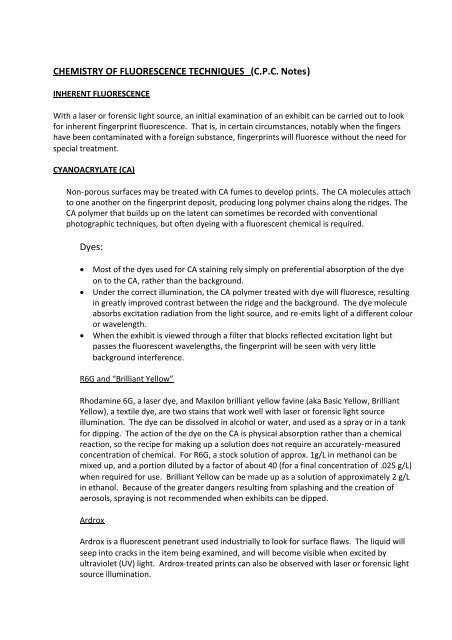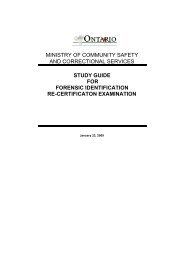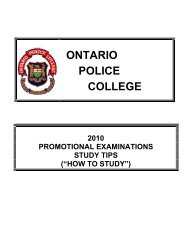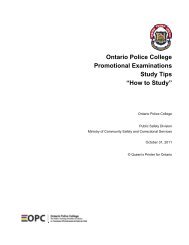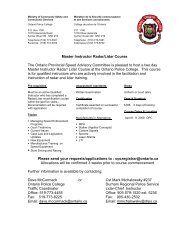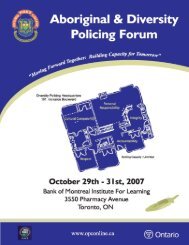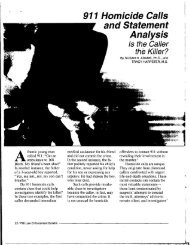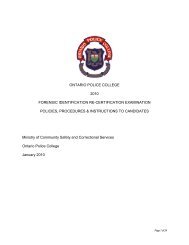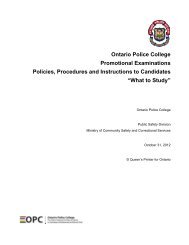General Study Guide - Ontario Police College
General Study Guide - Ontario Police College
General Study Guide - Ontario Police College
You also want an ePaper? Increase the reach of your titles
YUMPU automatically turns print PDFs into web optimized ePapers that Google loves.
CHEMISTRY OF FLUORESCENCE TECHNIQUES (C.P.C. Notes)<br />
INHERENT FLUORESCENCE<br />
With a laser or forensic light source, an initial examination of an exhibit can be carried out to look<br />
for inherent fingerprint fluorescence. That is, in certain circumstances, notably when the fingers<br />
have been contaminated with a foreign substance, fingerprints will fluoresce without the need for<br />
special treatment.<br />
CYANOACRYLATE (CA)<br />
Non-porous surfaces may be treated with CA fumes to develop prints. The CA molecules attach<br />
to one another on the fingerprint deposit, producing long polymer chains along the ridges. The<br />
CA polymer that builds up on the latent can sometimes be recorded with conventional<br />
photographic techniques, but often dyeing with a fluorescent chemical is required.<br />
Dyes:<br />
Most of the dyes used for CA staining rely simply on preferential absorption of the dye<br />
on to the CA, rather than the background.<br />
Under the correct illumination, the CA polymer treated with dye will fluoresce, resulting<br />
in greatly improved contrast between the ridge and the background. The dye molecule<br />
absorbs excitation radiation from the light source, and re-emits light of a different colour<br />
or wavelength.<br />
When the exhibit is viewed through a filter that blocks reflected excitation light but<br />
passes the fluorescent wavelengths, the fingerprint will be seen with very little<br />
background interference.<br />
R6G and “Brilliant Yellow”<br />
Rhodamine 6G, a laser dye, and Maxilon brilliant yellow favine (aka Basic Yellow, Brilliant<br />
Yellow), a textile dye, are two stains that work well with laser or forensic light source<br />
illumination. The dye can be dissolved in alcohol or water, and used as a spray or in a tank<br />
for dipping. The action of the dye on the CA is physical absorption rather than a chemical<br />
reaction, so the recipe for making up a solution does not require an accurately-measured<br />
concentration of chemical. For R6G, a stock solution of approx. 1g/L in methanol can be<br />
mixed up, and a portion diluted by a factor of about 40 (for a final concentration of .025 g/L)<br />
when required for use. Brilliant Yellow can be made up as a solution of approximately 2 g/L<br />
in ethanol. Because of the greater dangers resulting from splashing and the creation of<br />
aerosols, spraying is not recommended when exhibits can be dipped.<br />
Ardrox<br />
Ardrox is a fluorescent penetrant used industrially to look for surface flaws. The liquid will<br />
seep into cracks in the item being examined, and will become visible when excited by<br />
ultraviolet (UV) light. Ardrox-treated prints can also be observed with laser or forensic light<br />
source illumination.


